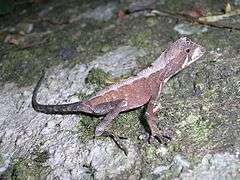Otocryptis beddomei
| Indian Kangaroo Lizard | |
|---|---|
 | |
| Scientific classification | |
| Kingdom: | Animalia |
| Phylum: | Chordata |
| Subphylum: | Vertebrata |
| Class: | Reptilia |
| Order: | Squamata |
| Suborder: | Iguania |
| Family: | Agamidae |
| Subfamily: | Draconinae |
| Genus: | Otocryptis |
| Species: | beddomei |
| Binomial name | |
| Otocryptis beddomei Boulenger, 1885 | |
| Synonyms | |
|
Otocryptis beddomii | |
The Indian Kangaroo Lizard (Otocryptis beddomei) is a species of agamid lizard found in south India (Thenmala in Kerala; Western Ghats; previously reported from Courtallam hills; Sivagiri Ghats, Cardamom Hills). The species is named after Richard Henry Beddome, 1830–1911, British army officer and botanist. It is related to the Sri Lankan Kangaroo Lizard (Otocryptis wiegmanni). The common name is derived from their habit of running on their hind legs with the body held upright.
Description

From snout to vent it is about 1.75 inches (4.4 cm) long with a tail of about 3 inches (7.6 cm). The head is covered in scales that have a sharp keel running along the centre, a feature also found in the Sri Lankan species. The scales on the head between the eyes are smaller and form about two or three longitudinal series. An inverted Y shape is formed by the keels of the scales but is indistinct. The canthus rostralis (or snout) is not prominent. There are 9 or 10 scales on the upper and lower lip. There are small pits on each side of the neck and in front of the shoulder. The scales on the back are unequal in size with the larger ones forming regular V-shaped marks with the point facing backwards. enlarged ones sometimes forming regular chevrons on the back, with the point facing backward. The scales on the underside are larger than those above. The scales on the side small but with large scales interspersed. The scales on the upperside of the legs have large keeled scales. When the hind leg is held along the body, the tip of the foot reaches the snout, the heel reaching the ear opening. The tail is round and slender and about two times the length of the head and body. The tail is covered by strongly keeled scales. The colour is olive brown with patches of dark brown on the back and limbs. A dark oblique band runs below the eye to the mouth. The underside is whitish and young lizards have a brown throat.[2]
The species distribution is highly fragmented in patches of dense forest in the Western Ghats south of the Palghat Gap.[3] They appear to be sensitive to human disturbance. A record from Kodaikanal has been considered to be in error.[4][5]
References
- ↑ Srinivasulu, C., Ganesan, S.R. & Vijayakumar, S.P. (2013). "Otocryptis beddomei". IUCN Red List of Threatened Species. IUCN. 2013: e.T173021A1375696. Retrieved 10 November 2015.
- ↑ Boulenger, George Albert (1885). Catalogue of the Lizards in the British Museum (Natural History) I. Geckonidae, Eublepharidae, Uroplatidae, Pygopodidae, Agamidae. London: British Museum. pp. 272–273.
- ↑ Jose, J; Ramachandran, KK; Nair PV (2007). "A rare and little known lizard, Otocryptis beddomi, from the Myristica swamps of southern Kerala, India". Herpetological Bulletin. 101: 27–31.
- ↑ Murthy, T. S. N. (1980). "Recent rediscovery of the rare agamid lizard Otocryptis beddomii". Journal of the Bombay Natural History Society. 77 (2): 343–344.
- ↑ Chandramouli SR (2009). "Status and microhabitat preference of Otocryptis beddomii Boulenger, 1885 (Reptilia: Agamidae) in Ponmudi Hills, Western Ghats, Kerala, India". Taprobanica: The Journal of Asian Biodiversity. 1 (2). doi:10.4038/tapro.v1i2.2763.
External links
| Wikimedia Commons has media related to Otocryptis beddomei. |
